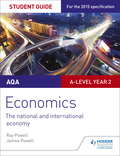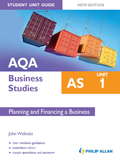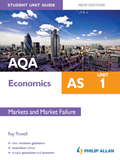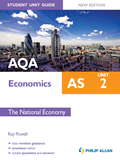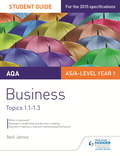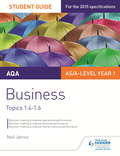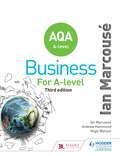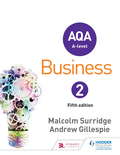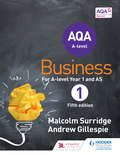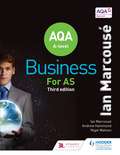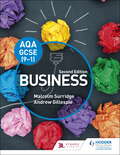- Table View
- List View
AQA A-level Economics Student Guide 3: Individuals, firms, markets and market failure
by James Powell Ray PowellWritten by experienced teachers Ray Powell and James Powell, this Student Guide for Economics:- Identifies the key content you need to know with a concise summary of topics examined in the A-level specifications-Enables you to measure your understanding with exam tips and knowledge check questions, with answers at the end of the guide-Helps you to improve your exam technique with sample answers to exam-style questions-Develops your independent learning skills with content you can use for further study and research
AQA A-level Economics Student Guide 4: The national and international economy
by James Powell Ray PowellWritten by experienced teachers Ray Powell and James Powell, this Student Guide for Economics:-Identifies the key content you need to know with a concise summary of topics examined in the A-level specifications-Enables you to measure your understanding with exam tips and knowledge check questions, with answers at the end of the guide-Helps you to improve your exam technique with sample answers to exam-style questions-Develops your independent learning skills with content you can use for further study and research
AQA A-level Politics Student Guide 3: Political Ideas
by Simon LemieuxWritten by experienced teacher Simon Lemieux, this Student Guide for Politics:-Identifies the key content you need to know with a concise summary of topics examined in the A-level specifications-Enables you to measure your understanding with exam tips and knowledge check questions, with answers at the end of the guide-Helps you to improve your exam technique with sample answers to exam-style questions-Develops your independent learning skills with content you can use for further study and research
AQA AS Business Studies: Student Unit Guide
by John WolinskiWritten by a senior examiner, John Wolinski, this AQA AS Business Studies Student Unit Guide is the essential study companion for Unit 1: Planning and Financing a Business.
AQA AS Economics Student Unit Guide: Unit 1 Markets & Market Failure
by Ray PowellWritten by a senior examiner, Ray Powell, this AQA AS Economics Student Unit Guide is the essential study companion for Unit 1: Markets and Market Failure. This full-colour book includes all you need to know to prepare for your unit exam: clear guidance on the content of the unit, with topic summaries, knowledge check questions and a quick-reference index, examiner's advice throughout, so you will know what to expect in the exam and will be able to demonstrate the skills required and exam-style questions, with graded student responses, so you can see clearly what is required to get a better grade.
AQA AS Economics Student Unit Guide: Unit 2 New Edition The National Economy
by Ray PowellWritten by a senior examiner, Ray Powell, this AQA AS Economics Student Unit Guide is the essential study companion for Unit 2: The National Economy.This full-colour book includes all you need to know to prepare for your unit exam: clear guidance on the content of the unit, with topic summaries, knowledge check questions and a quick-reference index examiner's advice throughout, so you will know what to expect in the exam and will be able to demonstrate the skills required exam-style questions, with graded student responses, so you can see clearly what is required to get a better grade
AQA AS/A-level Politics Student Guide 1: Government of the UK
by Paul Fairclough Nick GallopReinforce your understanding throughout the course. Clear topic summaries with sample questions and answers will help you improve your exam technique to achieve higher grades.Written by experienced teachers Nick Gallop and Paul Fairclough, this Student Guide for Politics:-Identifies the key content you need to know with a concise summary of topics examined in the AS/A-level specifications-Enables you to measure your understanding with exam tips and knowledge check questions, with answers at the end of the guide-Helps you to improve your exam technique with sample answers to exam-style questions-Develops your independent learning skills with content you can use for further study and research
AQA AS/A-level Politics Student Guide 1: Government of the UK
by Paul Fairclough Nick GallopExam board: AQALevel: A-levelSubject: PoliticsFirst teaching: September 2017First exams: Summer 2018 (AS) Summer 2019 (A-Level)Reinforce your understanding throughout the course. Clear topic summaries with sample questions and answers will help you improve your exam technique to achieve higher grades.Written by experienced teachers Nick Gallop and Paul Fairclough, this Student Guide for Politics:-Identifies the key content you need to know with a concise summary of topics examined in the AS/A-level specifications-Enables you to measure your understanding with exam tips and knowledge check questions, with answers at the end of the guide-Helps you to improve your exam technique with sample answers to exam-style questions-Develops your independent learning skills with content you can use for further study and research
AQA AS/A-level Politics Student Guide 2: Politics of the UK
by Nick GallopWritten by experienced teachers Nick Gallop and Paul Fairclough, this Student Guide for Politics:-Identifies the key content you need to know with a concise summary of topics examined in the AS/A-level specifications-Enables you to measure your understanding with exam tips and knowledge check questions, with answers at the end of the guide-Helps you to improve your exam technique with sample answers to exam-style questions-Develops your independent learning skills with content you can use for further study and research
AQA AS/A-level Politics Student Guide 2: Politics of the UK
by Nick GallopExam board: AQALevel: A-levelSubject: PoliticsFirst teaching: September 2017First exams: Summer 2018 (AS) Summer 2019 (A-Level)Written by experienced teachers Nick Gallop and Paul Fairclough, this Student Guide for Politics:-Identifies the key content you need to know with a concise summary of topics examined in the AS/A-level specifications-Enables you to measure your understanding with exam tips and knowledge check questions, with answers at the end of the guide-Helps you to improve your exam technique with sample answers to exam-style questions-Develops your independent learning skills with content you can use for further study and research
AQA Business Student Guide 1: Topics 1.1-1.3
by Neil James Isobel Rollitt JamesWritten by experienced examiner Neil James, this Student Guide for Business: - Identifies the key content you need to know with a concise summary of topics examined in the AS and A-level specifications - Enables you to measure your understanding with exam tips and knowledge check questions, with answers at the end of the guide - Helps you to improve your exam technique with sample answers to exam-style questions - Develops your independent learning skills with content you can use for further study and research
AQA Business Student Guide 2: Topics 1.4-1.6
by Neil JamesWritten by experienced examiner Neil James, this Student Guide for Business:- Identifies the key content you need to know with a concise summary of topics examined in the AS and A-level specifications- Enables you to measure your understanding with exam tips and knowledge check questions, with answers at the end of the guide- Helps you to improve your exam technique with sample answers to exam-style questions- Develops your independent learning skills with content you can use for further study and research
AQA Business for A Level (Marcousé)
by Ian Marcouse Nigel Watson Andrew HammondExam Board: AQALevel: AS/A-levelSubject: BusinessFirst Teaching: September 2015First Exam: June 2016Ian Marcousé has been trusted by Business students for over 15 years and his updated textbook has been fully revised to reflect the 2015 AQA Business specification, giving you up-to-date material that supports your teaching and student's learning.- Guides students through the content in an easy to understand way, with the new 'logic chain' feature at the start of every chapter showing them the progression clearly- Helps students apply their knowledge and analyse business data with real business examples throughout- Consolidates students' learning and prepares them for assessment with the workbook feature at the end of every chapter containing knowledge check and practice questions
AQA Business for A Level 1 (Surridge & Gillespie)
by Malcolm Surridge Andrew GillespieThis textbook has been fully revised to reflect the 2015 AQA Business specification, giving you up-to-date material that supports your teaching and student's learning.- Builds up quantitative skills with 'Maths moment' features and assesses them in the end of chapter activities - Ensures students have the knowledge of real life businesses so they can apply their theoretical understanding with the 'Business in focus' feature- Helps students get to grips with the content and tests key skills with activities at the end of every chapter
AQA Business for A Level 1 (Surridge & Gillespie)
by Malcolm Surridge Andrew GillespieExam Board: AQALevel: AS/A-levelSubject: BusinessFirst Teaching: September 2015First Exam: June 2016Surridge and Gillespie are back, helping students of all abilities reach their goal; develop students' quantitative and analytical skills, knowledge and ability to apply theoretical understanding through real life business examples and varied activities.This textbook has been fully revised to reflect the 2015 AQA Business specification, giving you up-to-date material that supports your teaching and student's learning.- Builds up quantitative skills with 'Maths moment' features and assesses them in the end of chapter activities - Ensures students have the knowledge of real life businesses so they can apply their theoretical understanding with the 'Business in focus' feature- Helps students get to grips with the content and tests key skills with activities at the end of every chapter
AQA Business for AS (Marcousé)
by Ian Marcouse Nigel Watson Andrew HammondDevelop understanding of business arguments and reasoning, with a clear progression pathway and case studies that illustrate core points.Ian Marcouse has been trusted by Business students for over 15 years and his updated textbook has been fully revised to reflect the 2015 AQA Business specification, giving you up-to-date material that supports your teaching and student's learning.- Guides students through the content in an easy to understand way, with the new 'logic chain' feature at the start of every chapter showing them the progression clearly- Helps students apply their knowledge and analyse business data with real business examples throughout- Consolidates students' learning and prepares them for assessment with the workbook feature at the end of every chapter containing knowledge check and practice questions
AQA GCSE (9-1) Business
by Malcolm Surridge Andrew GillespieSelected for an AQA approval processBenefit from the expert guidance of Surridge and Gillespie; this new edition of their well-known Student Book provides up-to-date content, real business examples and assessment preparation materials that help every student achieve their best in the 2017 specification. Builds understanding of business concepts through accessible explanations, supported by definitions of key terms and tips that highlight important points and common misconceptions. Enables students to apply their knowledge to real business examples, issues and contexts in the 'Business insight' feature. Develops investigative, analytical and evaluation skills through multiple choice, short answer and case study/data response questions, sample answers and commentary. Encourages students to track their progress using learning outcomes, end-of-chapter summaries and knowledge-check questions. Helps students practise and improve their quantitative skills via the 'Maths moment' feature. Stretches students with questions that test their ability to make an informed judgement.
AQA GCSE (9-1) Business, Third Edition
by Malcolm Surridge Andrew GillespieWith up-to-date case studies of real-world businesses, this fully updated AQA GCSE (9-1) Business Student Textbook will help your students respond to exam questions with confidence, demonstrating how they can structure their answers for maximum impact. This Student Textbook includes:- Fully up-to-date exam questions, with 25% more practice questions and increased practical support for tackling different question types- More exam tips and advice, with examiner commentary showing how students should approach exam questions- Real-world case studies, new and updated, to reflect the developments in e-commerce and the impact of recent global and political developments- Quick knowledge-recall questions throughout the book to help students check understanding, and for teachers to use in assessment
AQA GCSE (9-1) Business, Third Edition
by Malcolm Surridge Andrew GillespieWith up-to-date case studies of real-world businesses, this fully updated AQA GCSE (9-1) Business Student Textbook will help your students respond to exam questions with confidence, demonstrating how they can structure their answers for maximum impact. This Student Textbook includes:- Fully up-to-date exam questions, with 25% more practice questions and increased practical support for tackling different question types- More exam tips and advice, with examiner commentary showing how students should approach exam questions- Real-world case studies, new and updated, to reflect the developments in e-commerce and the impact of recent global and political developments- Quick knowledge-recall questions throughout the book to help students check understanding, and for teachers to use in assessment
AQA GCSE Food Preparation & Nutrition: Revision Guide
by Anita TullWritten by leading food author Dr Anita Tull, this revision guide provides you with reassuring support as you study through the course, and all the essential knowledge you need to revise for your written exam. // The information is presented in a colourful and highly visual way. // Summaries are included for every topic in the course. // Mindmaps help you remember what you are revising. // Key terms you need for your exam answers are provided for every topic. // Activities help you learn the topics and test your knowledge. // Revision Tips give you ideas and suggestions about different ways of revising. // Exam skills and techniques are reinforced with a dedicated chapter of advice and guidance. // Practice exam-style questions (with answers available) enable you to test yourself and provide plenty of practice for the exam.
AQA GCSE Food Preparation and Nutrition Second Edition
by Anita Tull Yvonne Mackey Bev SaunderThis title has been submitted for approval by AQA.Motivate all learners to build their knowledge and skills so they can approach both practical and written assessments with confidence. Written by a leading author team, our new edition textbook has been specifically designed to provide comprehensive, accessible and engaging content for AQA GCSE Food Preparation and Nutrition.- Easily deliver your course with structured and comprehensive coverage of the specification, supporting both specialist and non-specialist teachers- Enable students of all ability levels to progress, with accessible language, clear layout and photographs used throughout to bring the content to life- Help students understand the relevance of food science with revised content, including more scaffolding and guidance on how to apply their knowledge in the context of assessment- Build students' knowledge and skills with key term definitions, study tips and activities, including practical tasks to help them prepare for the NEA component- Consolidate learning with short practice questions that check understanding, plus exam-style questions to help students prepare for assessment, with all answers provided in the book
AQA GCSE Food Preparation and Nutrition Second Edition
by Anita Tull Yvonne Mackey Bev SaunderThis title has been submitted for approval by AQA.Motivate all learners to build their knowledge and skills so they can approach both practical and written assessments with confidence. Written by a leading author team, our new edition textbook has been specifically designed to provide comprehensive, accessible and engaging content for AQA GCSE Food Preparation and Nutrition.- Easily deliver your course with structured and comprehensive coverage of the specification, supporting both specialist and non-specialist teachers- Enable students of all ability levels to progress, with accessible language, clear layout and photographs used throughout to bring the content to life- Help students understand the relevance of food science with revised content, including more scaffolding and guidance on how to apply their knowledge in the context of assessment- Build students' knowledge and skills with key term definitions, study tips and activities, including practical tasks to help them prepare for the NEA component- Consolidate learning with short practice questions that check understanding, plus exam-style questions to help students prepare for assessment, with all answers provided in the book
AQA GCSE Food Preparation and Nutrition: Revision Guide
by Garry Littlewood Anita TullApproved by AQA, this student book offers high quality support you can trust. Written by renowned author Anita Tull and Garry Littlewood, this resource is designed to be the most motivating student-friendly book available. Its engaging visual style and tone will support your students through this new course and help them thoroughly prepare for both their non-examined assessment tasks and exam. / Designed for students of all ability level. / Knowledge and understanding covers the specification content in the right level of detail and is written and presented in a highly accessible way. / Recipes make the links between food preparation skills and the science of food and nutrition. / Practical activities help your students connect theory and practice, and apply their understanding of food and nutrition to practical preparation. / Non-Exam Assessment tasks are supported with a chapter giving you clear guidance on how you will be assessed./Exam practice and skills guidance is provided, introducing students to the assessment criteria and mark schemes. / Extension questions and tasks will help stretch and challenge the most able learners.
AQR's Momentum Funds (A)
by Randolph B. Cohen Daniel B. Bergstresser Lauren H. Cohen Christopher MalloyAQR is a hedge fund based in Greenwich, Connecticut, that is considering offering a wholly new line of product to retail investors, namely the ability to invest in the price phenomenon known as momentum. There is a large body of empirical evidence supporting momentum across many different asset classes and countries. However, up until this point, momentum was a strategy employed nearly exclusively by hedge funds, and thus not an available investment strategy to most individual investors. This case highlights the difficulties in implementing this "mutual fund-itizing" of a hedge fund product, along with the challenges that the open-end and regulatory features that a mutual fund poses to many successful strategies implemented in other contexts. In addition, it gives students the ability to calculate and interpret various horizons of correlations between many popular investment strategies using long time-series data and then thinking about the potential complementarities of strategies from a portfolio construction context.
ARISE: A Destination-for-a-Day Spa
by Michael Beer Lynda St. ClairA new Dallas-based health and beauty spa aims to use a highly distinctive human resource system as the foundation of its competitive strategy. By encouraging employees to act as "personal wellness coaches" (PWCs) with high commitment and broad responsibilities, the leadership intended to provide a level of client service that would justify premium rates. However, the system is not working. Issues include: tips are lower than expected, reducing expected compensation; scheduling issues create bottlenecks; and the level of commitment varies among PWCs. The result is a high employee turnover rate, and departing employees take an average of 35% of their client base with them when they go. Now, with financials for the spa's second year completed, the VP of spa operations, the VP of business operations, and the CEO must evaluate what is and what isn't working.

